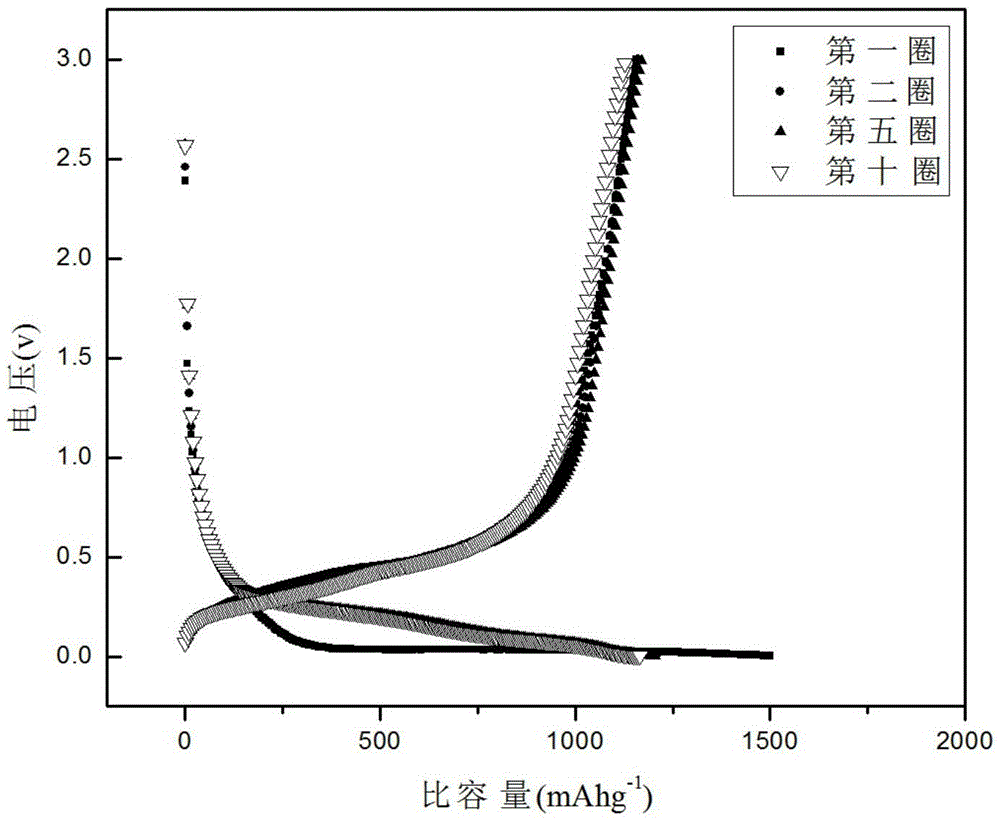Silicon/silicon oxycarbide/carbon anode material and preparation method and application thereof
A carbon anode material, silicon oxycarbide technology, applied in battery electrodes, electrochemical generators, electrical components, etc., can solve the problems of phase separation, poor bonding, stable electrode structure, and inability to effectively absorb stress together. To achieve the effect of easy control of conditions, simple process, and reduction of adverse consequences
- Summary
- Abstract
- Description
- Claims
- Application Information
AI Technical Summary
Problems solved by technology
Method used
Image
Examples
Embodiment 1
[0027] Step (1). Stir and mix 99.9g bisphenol A epoxy vinyl ester resin and 0.1g vinyltrimethoxysilane at room temperature to obtain 100g mixed solution;
[0028] Step (2). Add 0.1 g of silicon nanoparticles to the above 9.9 g of the reaction solution, and ultrasonically stir for 3 minutes to obtain a uniformly dispersed slurry;
[0029] Step (3) Stir 9.98g of the above-mentioned mixed solution containing silicon nanoparticles and 0.02g of benzoyl peroxide at room temperature for 1 minute, mix well and pour into a tetrafluoroethylene mold, heat-cure at 80°C to obtain silicon / Polysiloxane / carbon precursor composite solid material;
[0030] Step (4). Grinding the silicon / polysiloxane / carbon precursor composite solid material for 1 minute to obtain solid particles;
[0031] Step (5). Calcining the above-mentioned solid particles at 800° C. for 4 hours under an inert atmosphere of argon to obtain solid particles of silicon / silicon oxycarbide / carbon negative electrode material; ...
Embodiment 2
[0035] Step (1). Stir and mix 50g bisphenol A-diglycidyl ether methacrylate and 50g vinyl triethoxysilane at room temperature to obtain 100g mixed solution;
[0036] Step (2). Add 0.8 g of silicon nanoparticles to the above 9.2 g of the reaction solution, and ultrasonically stir for 30 minutes to obtain a uniformly dispersed slurry;
[0037] Step (3) Stir the above 9.8g mixed solution containing silicon nanoparticles and 0.2g di(2,4-dichlorobenzoyl) peroxide at room temperature for 3 minutes, mix well and inject into the tetrafluoroethylene mold, Thermally cured at 150°C to obtain a silicon / polysiloxane / carbon precursor composite solid material;
[0038] Step (4). Grinding the silicon / polysiloxane / carbon precursor composite solid material for 5 minutes to obtain solid particles;
[0039] Step (5). Calcining the above-mentioned solid particles at 800° C. for 10 hours under an inert nitrogen atmosphere to obtain solid particles of silicon / silicon oxycarbide / carbon negative elec...
Embodiment 3
[0042] Step (1). Stir and mix 99.5g tetraethylene glycol dimethacrylate and 0.5g vinyl tris(b-methoxyethoxy)silane at room temperature to obtain 100g mixed solution;
[0043] Step (2). Add 0.2 g of silicon nanoparticles to the above 9.8 g of the reaction solution, and ultrasonically stir for 5 minutes to obtain a uniformly dispersed slurry;
[0044]Step (3) Stir 9.95g of the above-mentioned mixed solution containing silicon nanoparticles and 0.05g of diacetyl peroxide at room temperature for 2 minutes, mix well and pour into a tetrafluoroethylene mold, heat cure at 85°C to obtain silicon / polyethylene Siloxane / carbon precursor composite solid materials;
[0045] Step (4). Grinding the silicon / polysiloxane / carbon precursor composite solid material for 2 minutes to obtain solid particles;
[0046] Step (5). Calcining the above-mentioned solid particles at 800° C. for 5 hours under an inert atmosphere of nitrogen to obtain solid particles of silicon / silicon oxycarbide / carbon nega...
PUM
| Property | Measurement | Unit |
|---|---|---|
| Diameter | aaaaa | aaaaa |
| Particle size | aaaaa | aaaaa |
Abstract
Description
Claims
Application Information
 Login to View More
Login to View More - R&D
- Intellectual Property
- Life Sciences
- Materials
- Tech Scout
- Unparalleled Data Quality
- Higher Quality Content
- 60% Fewer Hallucinations
Browse by: Latest US Patents, China's latest patents, Technical Efficacy Thesaurus, Application Domain, Technology Topic, Popular Technical Reports.
© 2025 PatSnap. All rights reserved.Legal|Privacy policy|Modern Slavery Act Transparency Statement|Sitemap|About US| Contact US: help@patsnap.com

